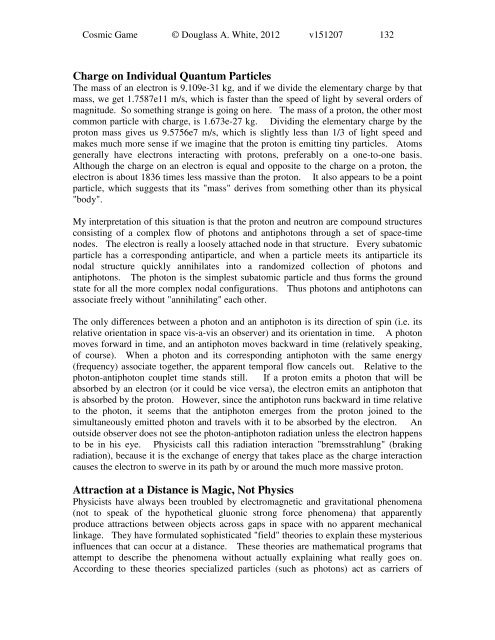Create successful ePaper yourself
Turn your PDF publications into a flip-book with our unique Google optimized e-Paper software.
<strong>Cosmic</strong> <strong>Game</strong> © Douglass A. White, 2012 v151207 132<br />
Charge on Individual Quantum Particles<br />
<strong>The</strong> mass of an electron is 9.109e-31 kg, and if we divide the elementary charge by that<br />
mass, we get 1.7587e11 m/s, which is faster than the speed of light by several orders of<br />
magnitude. So something strange is going on here. <strong>The</strong> mass of a proton, the other most<br />
<strong>com</strong>mon particle with charge, is 1.673e-27 kg. Dividing the elementary charge by the<br />
proton mass gives us 9.5756e7 m/s, which is slightly less than 1/3 of light speed and<br />
makes much more sense if we imagine that the proton is emitting tiny particles. Atoms<br />
generally have electrons interacting with protons, preferably on a one-to-one basis.<br />
Although the charge on an electron is equal and opposite to the charge on a proton, the<br />
electron is about 1836 times less massive than the proton. It also appears to be a point<br />
particle, which suggests that its "mass" derives from something other than its physical<br />
"body".<br />
My interpretation of this situation is that the proton and neutron are <strong>com</strong>pound structures<br />
consisting of a <strong>com</strong>plex flow of photons and antiphotons through a set of space-time<br />
nodes. <strong>The</strong> electron is really a loosely attached node in that structure. Every subatomic<br />
particle has a corresponding antiparticle, and when a particle meets its antiparticle its<br />
nodal structure quickly annihilates into a randomized collection of photons and<br />
antiphotons. <strong>The</strong> photon is the simplest subatomic particle and thus forms the ground<br />
state for all the more <strong>com</strong>plex nodal configurations. Thus photons and antiphotons can<br />
associate freely without "annihilating" each other.<br />
<strong>The</strong> only differences between a photon and an antiphoton is its direction of spin (i.e. its<br />
relative orientation in space vis-a-vis an observer) and its orientation in time. A photon<br />
moves forward in time, and an antiphoton moves backward in time (relatively speaking,<br />
of course). When a photon and its corresponding antiphoton with the same energy<br />
(frequency) associate together, the apparent temporal flow cancels out. Relative to the<br />
photon-antiphoton couplet time stands still. If a proton emits a photon that will be<br />
absorbed by an electron (or it could be vice versa), the electron emits an antiphoton that<br />
is absorbed by the proton. However, since the antiphoton runs backward in time relative<br />
to the photon, it seems that the antiphoton emerges from the proton joined to the<br />
simultaneously emitted photon and travels with it to be absorbed by the electron. An<br />
outside observer does not see the photon-antiphoton radiation unless the electron happens<br />
to be in his eye. Physicists call this radiation interaction "bremsstrahlung" (braking<br />
radiation), because it is the exchange of energy that takes place as the charge interaction<br />
causes the electron to swerve in its path by or around the much more massive proton.<br />
Attraction at a Distance is Magic, Not Physics<br />
Physicists have always been troubled by electromagnetic and gravitational phenomena<br />
(not to speak of the hypothetical gluonic strong force phenomena) that apparently<br />
produce attractions between objects across gaps in space with no apparent mechanical<br />
linkage. <strong>The</strong>y have formulated sophisticated "field" theories to explain these mysterious<br />
influences that can occur at a distance. <strong>The</strong>se theories are mathematical programs that<br />
attempt to describe the phenomena without actually explaining what really goes on.<br />
According to these theories specialized particles (such as photons) act as carriers of





